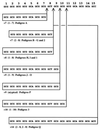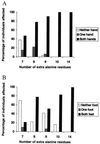Synpolydactyly phenotypes correlate with size of expansions in HOXD13 polyalanine tract
- PMID: 9207113
- PMCID: PMC23843
- DOI: 10.1073/pnas.94.14.7458
Synpolydactyly phenotypes correlate with size of expansions in HOXD13 polyalanine tract
Abstract
Synpolydactyly (SPD) is a dominantly inherited congenital limb malformation. Typical cases have 3/4 finger and 4/5 toe syndactyly, with a duplicated digit in the syndactylous web, but incomplete penetrance and variable expressivity are common. The condition has recently been shown to be caused by expansions of an imperfect trinucleotide repeat sequence encoding a 15-residue polyalanine tract in HOXD13. We have studied 16 new and 4 previously published SPD families, with between 7 and 14 extra residues in the tract, to analyze the molecular basis for the observed variation in phenotype. Although there is no evidence of change in expansion size within families, even over six generations, there is a highly significant increase in the penetrance and severity of phenotype with increasing expansion size, affecting both hands (P = 0.012) and feet (P < 0. 00005). Affected individuals from a family with a 14-alanine expansion, the largest so far reported, all have a strikingly similar and unusually severe limb phenotype, involving the first digits and distal carpals. Affected males from this family also have hypospadias, not previously described in SPD, but consistent with HOXD13 expression in the developing genital tubercle. The remarkable correlation between phenotype and expansion size suggests that expansion of the tract leads to a specific gain of function in the mutant HOXD13 protein, and has interesting implications for the role of polyalanine tracts in the control of transcription.
Figures





References
-
- Muragaki Y, Mundlos S, Upton J, Olsen B. Science. 1996;272:548–551. - PubMed
-
- Akarsu A, Stoilov I, Yilmaz E, Sayli B, Sarfarazi M. Hum Mol Genet. 1996;5:945–952. - PubMed
-
- Temtamy S, McKusick V. Birth Defects: Original Article Series. Vol. 14. New York: Liss; 1978. pp. 301–322. - PubMed
-
- Thomsen O. Acta Med Scand. 1927;65:609–644.
Publication types
MeSH terms
Substances
Associated data
- Actions
- Actions
Grants and funding
LinkOut - more resources
Full Text Sources
Other Literature Sources
Molecular Biology Databases

